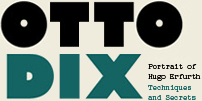
Otto Dix
Hugo Erfurth, 1922
Pencil on cardboard. 50 x 45,2 cm
Von der Heydt-Museum, Wuppertal
© Medienzentrum Wuppertal / foto: Assunta Windgasse
Hugo Erfurth, 1922
Pencil on cardboard. 50 x 45,2 cm
Von der Heydt-Museum, Wuppertal
© Medienzentrum Wuppertal / foto: Assunta Windgasse

Otto Dix
Hugo Erfurth with Cigarette, 1922
Ink on paper. 53,5 x 40,5 cm
Kunstsammlung Gera. Depósito de colección privada
© Ulrich Fischer
Hugo Erfurth with Cigarette, 1922
Ink on paper. 53,5 x 40,5 cm
Kunstsammlung Gera. Depósito de colección privada
© Ulrich Fischer

Otto Dix
Hugo Erfurth with his Dog Ajax, 1926
Charcoal and pencil on paper mounted on cardboard.
84,3 x 100,2 cm
Staatliche Museen zu Berlin, Kupferstichkabinett, Berlín
© bpk, Kupferstichkabinett, SMB - Berlín 2008, foto: Jörg P. Anders
Hugo Erfurth with his Dog Ajax, 1926
Charcoal and pencil on paper mounted on cardboard.
84,3 x 100,2 cm
Staatliche Museen zu Berlin, Kupferstichkabinett, Berlín
© bpk, Kupferstichkabinett, SMB - Berlín 2008, foto: Jörg P. Anders

Otto Dix
Hugo Erfurth with Dog, 1926
Tempera and oil on panel. 80 x 100 cm.
Museo Thyssen-Bornemisza, Madrid
Hugo Erfurth with Dog, 1926
Tempera and oil on panel. 80 x 100 cm.
Museo Thyssen-Bornemisza, Madrid

Otto Dix
German Shepherd, 1928
Tempera and oil on panel. 80 x 97 cm
Hans Brockstedt, Hamburgo
Foto: Nicolai Stephan © 2007
German Shepherd, 1928
Tempera and oil on panel. 80 x 97 cm
Hans Brockstedt, Hamburgo
Foto: Nicolai Stephan © 2007

Otto Dix
Self-Portrait with Easel, 1926
Tempera and oil on panel. 80,5 x 55,5 cm
Leopold-Hoesch-Museum, Düren
Self-Portrait with Easel, 1926
Tempera and oil on panel. 80,5 x 55,5 cm
Leopold-Hoesch-Museum, Düren

Hugo Erfurth
Self-Portrait, 1925
Silver gelatine. 35,7 x 29,3 cm
Museum Ludwig, Colonia (Collection of Photographs)
Repro: Rheinisches Bildarchiv Köln
Self-Portrait, 1925
Silver gelatine. 35,7 x 29,3 cm
Museum Ludwig, Colonia (Collection of Photographs)
Repro: Rheinisches Bildarchiv Köln

Hugo Erfurth
Otto Dix with Cigarette, 1926
Oil pigment print. 31,3 x 25 cm
Otto Dix Stiftung, Vaduz
Otto Dix with Cigarette, 1926
Oil pigment print. 31,3 x 25 cm
Otto Dix Stiftung, Vaduz

Hugo Erfurth
Otto Dix in front of his Self-Portrait with Martha, 1922
Photograph. 13,9 x 8,8 cm
Kunstsammlung Gera, Dix-Archiv
© Ulrich Fischer
Otto Dix in front of his Self-Portrait with Martha, 1922
Photograph. 13,9 x 8,8 cm
Kunstsammlung Gera, Dix-Archiv
© Ulrich Fischer

Hugo Erfurth
Otto Dix with Carnation, 1929
Oil print. 24,5 x 31 cm
Museum Ludwig, Colonia (Collection of Photographs)
Repro: Rheinisches Bildarchiv Köln
Otto Dix with Carnation, 1929
Oil print. 24,5 x 31 cm
Museum Ludwig, Colonia (Collection of Photographs)
Repro: Rheinisches Bildarchiv Köln

Hugo Erfurth
Otto Dix, 1929
Oil print. 47 x 37,5 cm
Museum Ludwig, Colonia (Collection of Photographs)
Repro: Rheinisches Bildarchiv Köln
Otto Dix, 1929
Oil print. 47 x 37,5 cm
Museum Ludwig, Colonia (Collection of Photographs)
Repro: Rheinisches Bildarchiv Köln

On his arrival in Dresden in 1919, Otto Dix made contact with numerous figures in the city’s cultural circles. Hugo Erfurth was one such figure. Fifteen years old than Dix, Erfurth was by that time an established photographer and his studio welcomed the leading personalities of the German Weimar Republic. Erfurth’s interest in assembling a “gallery of heads of my time” meant that he was also keen to photograph the new generation of artists living in Dresden, who from 1920 included Dix. Slightly later it would be Dix, who also had a distinctive approach to portraiture, who portrayed Erfurth on a number of occasions (1922, 1925 and 1926).
Dix and Erfurth established a close relationship based on artistic interchange, and Dix executed various portraits of Erfurth, his wife and even his dog. In turn, Erfurth immortalised Dix on numerous occasions and in different dress, together with his wife Martha, their children and parents. In addition, Erfurth, who owned a gallery in Dresden, was extremely interested in acquiring works on paper by Dix, while the painter in turn used Erfurth’s photographs of World War I as the basis for his series of etchings on the war.
The 20 works included in the exhibition reveal the mutual influences that grew up between Dix and Erfurth as a consequence of their regular contacts. They introduce us to a key artistic debate of the middle years of the Weimar Republic concerning the respective merits of painting and photography and which was the superior art form. The exhibition analyses to what degree Dix’s realist style may have influenced Erfurth’s cool, objective portraits, and in contrast, to what extent Dix adopted certain elements characteristic of Erfurth’s photographic portraits.
Dix and Erfurth established a close relationship based on artistic interchange, and Dix executed various portraits of Erfurth, his wife and even his dog. In turn, Erfurth immortalised Dix on numerous occasions and in different dress, together with his wife Martha, their children and parents. In addition, Erfurth, who owned a gallery in Dresden, was extremely interested in acquiring works on paper by Dix, while the painter in turn used Erfurth’s photographs of World War I as the basis for his series of etchings on the war.
The 20 works included in the exhibition reveal the mutual influences that grew up between Dix and Erfurth as a consequence of their regular contacts. They introduce us to a key artistic debate of the middle years of the Weimar Republic concerning the respective merits of painting and photography and which was the superior art form. The exhibition analyses to what degree Dix’s realist style may have influenced Erfurth’s cool, objective portraits, and in contrast, to what extent Dix adopted certain elements characteristic of Erfurth’s photographic portraits.







